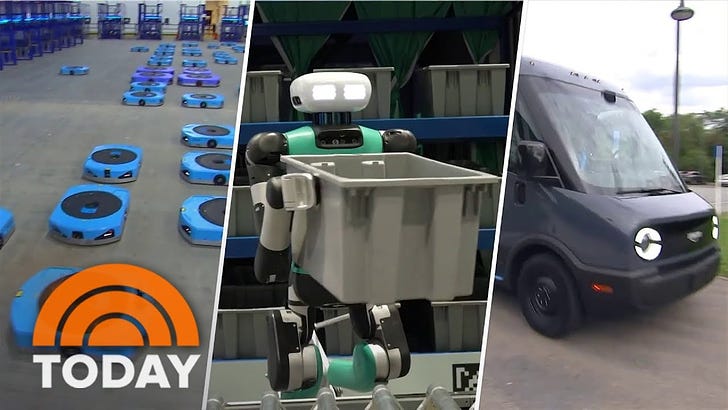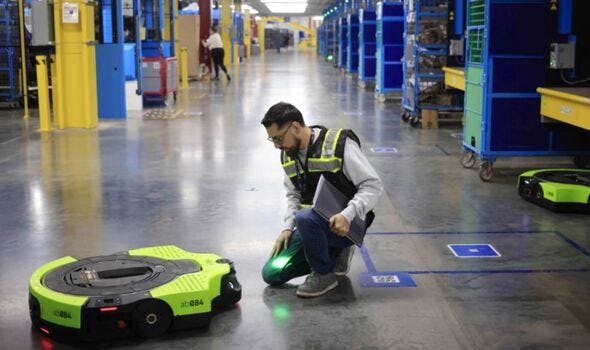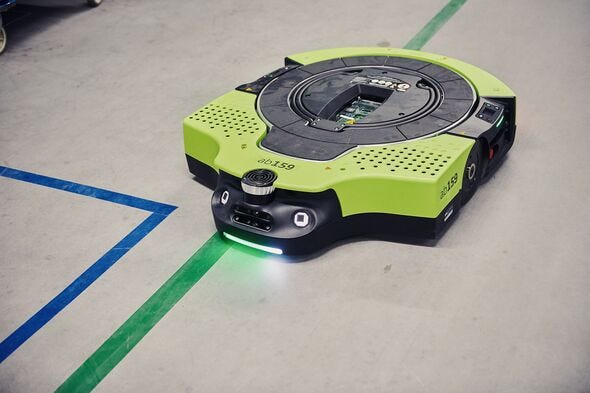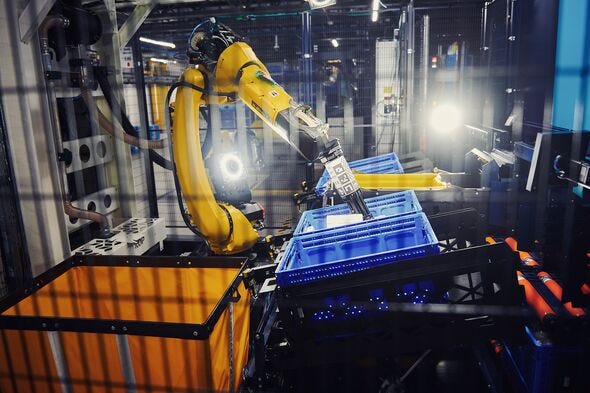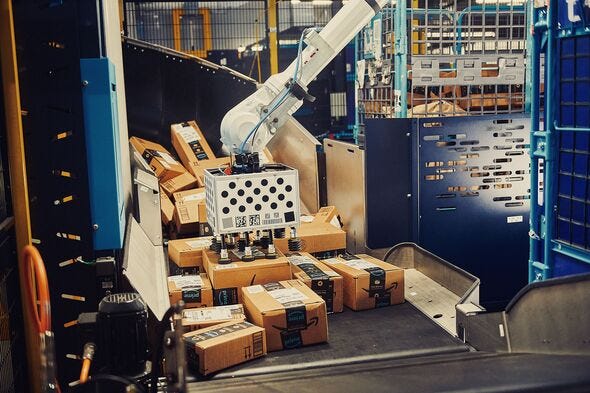Inside Amazon warehouses where robots have taken over and cry at humans
Amazon bought thousands of robots - and fired thousands of people - at these warehouses.... think about it next time you order from amazon
youtube.com/watch?v=2lIdVQbDmXM&t=37s
Amazon has entered an exciting new frontier with a huge deployment of robotics and AI technologies - but what do their human colleagues think?
18:05 ET, Thu, Oct 17, 2024 | UPDATED: 14:41 ET, Fri, Oct 18, 2024
Amazon Robotics Acceleration shown working in warehouse
Amazon warehouses have been taken over by robots with eyes than can yell at humans - and now they're treated as coworkers.
Robot humaoids will be coming into the home in five to 10 years and US army generals want to use robots on the frontlines, but they've already taken over Amazon's fulfillment center in Nashville, Tennessee.
Amazon has entered an exciting new frontier with the largest advancement in robotics and AI technologies deployed in the operation's history, with employees working alongside a growing fleet of robotic systems seamlessly in a way that wasn't possible until now.
Walking into the 3.5m square foot Nashville facility is like something out of a movie, with the remarkable Proteus robot whizzing around at your feet.
"Proteus is just so darn cute," says Julie Mitchell, Director at Amazon Robotics, who put to bed any fears that the "loveable" yet slightly creepy-looking autonomous mobile robot will one day try to take over the world.
She explained: "You'll notice the eyes move. Proteus will tell you where it's planning to go based on the signals it's giving you. It will shift its eyes. The trust and the collaboration has been there since day one."
Amazon's Proteus robot safely moves around human employees (Image: Amazon)
Proteus will go and charge itself when it's running out of juice, taking just eight minutes to be back navigating carts of packages weighing up to 880lb so they can be loaded into trucks.
If humans get in its way, Proteus is courteous enough to stop but does start making loud noises and it's green mouth turns red.
"When you hear 150 robots all day long, what's going to be an acceptable noise. We did a lot of studies and field testing," said Mitchell.
"What you hear today is not a grating noise, it's an inviting noise. That was on purpose.
"We wanted to make Proteus loveable and the feature face, the eyes that we put on it, the noises that it makes, was all purposefully designed to make it loveable."
With Proteus doing the heavy lifting, human workers have a "less taxing job" and can spend time on problem solving work.
Proteus is able to move across the floor by itself (Image: Amazon)
In it's two-year history, there have not been any safety incidents - and the giant green Roomba-lookalike is "not capable of going rogue" because it is simply task-based.
Elsewhere in the facility there is a small army of various robotic arms that bring items to employees at ergonomic workstations which are kept safely in special zones.
Sparrow can pick up and move o ver 200 million unique products of all different shapes, sizes, and weights to send to employees to be packaged.
While Cardinal uses advanced AI to select packages and "knows how to stack like some of the best Tetris players," according to Udit Madan, Vice President, Worldwide Operations.
The results are clear to see, with Amazon reporting a 25 per cent reduction in the cost of getting items to customers, but will humans be completely replaced?
Sparrow can detect, select and handle individual products (Image: Amazon)
"Automating doesn't mean there's little humans. It's a system that needs our employees to support it," explained Mitchell.
"There's always hiccups and things that will go wrong. This is the real world. We always need the support of our employees to keep the systems running and keep this uptide of robotics."
She added that it's "super fast and easy" to train people to repair their robots - and doesn't require a technical degree.
Amazon expect their sites to meaningfully build on the over 30% improvements in safety by improving the ergonomics and reducing the amount of heavy lifting across these facilities.
Their latest and largest next-generation fulfillment center, located in Shreveport, Louisiana, turns the robotic dial up even further.
Cardinal stacks packages like a Tetris player (Image: Amazon)
Spanning five floors and more than 3 million square feet, equivalent to 55 football fields, The Louisiana site will feature all of the previously mentioned robotics as well as Sequoia.
The state-of-the-art multilevel containerized inventory system can hold more than 30 million items - and will employ a staggering 2,500 human employees.
Critics have accused Amazon of taking away jobs from workers and there is some concern about things going wrong when humans collaborate directly with robots.
But Ben Armstrong, executive director and a research scientist at MIT, believes employers should not be attempting to minimize anxiety.
read more at
https://www.the-express.com/news/us-news/151144/amazon-robot-ai-facility-technology
